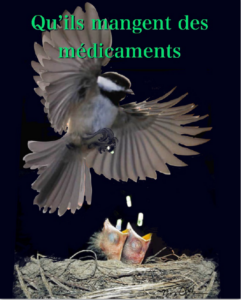
This is the first of two lectures organized by Fanny Dargent who has a longstanding interest in adolescence and its problems and the dangers of psychotropic medication, along with Ariane Denoyel, who has authored the French version of this lecture below, and is the author of Génération Zombie, the leading book in French on these issues.
The talk centres on the case of Romain Schmitt. For a more complete version of his story see Un antidépresseur a-t-il tué Romain ?
The second lecture looks at the bigger picture and goes so far as to rewrite the Creation Myth. It is at From the French Revolution to A.I.
Nina Otulakowski created the compelling artwork for Qu’ils Mangent des Médicaments.
Slide 2: Romain Schmitt n’avait que 16 ans quand il est mort – en se plaçant devant un train. Un beau garçon, l’air sympathique, qui avait beaucoup d’amis – probablement quelqu’un que vous auriez apprécié. Pour des problèmes d’abord très mineurs, il a été mis sous Deroxat et la situation est partie en vrille, sans que le système qui a conduit à cette situation soit remis en question. Le système – c’est-à-dire nous – n’a pas compris qu’il était lui-même à l’origine du problème – que nous sommes le problème – plutôt qu’un trouble inhérent à Romain.
Romain Schmitt was only 16 when he died – stepping in front of a train. He is handsome, looks friendly and had lots of friends – he looks like someone you would like to meet. He had very minor problems to begin with but was then put on Deroxat and things escalated out of control. The System – that is US – was unable to recognize that it was the problem – that We are the Problem – rather than any condition in him.
Slides 3: Le Haut Conseil de la famille, de l’enfance et de l’âge, un organisme public chargé de conseiller les services du Premier ministre en France, a publié voici quelques semaines un rapport dénonçant l’inquiétante surmédication dont font l’objet nos enfants et adolescents, et le fait que cela ne repose pas sur des données scientifiques. Plusieurs médias ont évoqué ce rapport et des groupes de pédopsychiatres ont réagi fortement.
A few weeks ago there was a major fuss when this document issued by an advisory board to the Prime Minister of France was reported in several newspapers. The document claimed that children and teens were heavily over-medicated and this was not evidence based. It triggered strong reactions from child psychiatrists.
Slide 4: Il s’est écoulé près de deux ans depuis la mort de Romain. Aujourd’hui, une partie des professionnels de santé mentale santé français semble reconnaître que les choses vont mal mais peine à identifier le problème. Ils se prononcent, comme le HCFEA, en faveur de plus de thérapie et moins de médicaments. Cela semble raisonnable, pourtant, cela risquerait d’empirer la situation. Mais Romain et ses parents ont commencé par suivre des séances de psychothérapie.
Since Romain’s death nearly 2 years ago, the French System seems to recognize it has a problem but doesn’t seem to know what the problem is. The System wants to give children more therapy rather than more drugs. This sounds reasonable but it is a measure of our denial that we cannot see that this risks making things worse. Romain and his parents began with psychotherapy sessions rather than drugs.
Slide 5: Yoko et Vincent, parents de Romain, que vous voyez sur cette photo prise voici quelques années, essaient d’établir la vérité sur la mort de leur fils mais le système français refuse de les entendre.
Romain’s parents – Yoko and Vincent whom you see here are also here this evening. They have done heroic work to establish what happened and at each turn have been confronted with and perplexed by the ability of the French System to deny there is any problem.
Slide 6: Un an après la mort de Romain, le New York Times a publié un article sur des adolescents américains qui se retrouvaient sous 10 psychotropes, voire plus. Des centaines de personnes ont souligné la pertinence de cet article – même le New York Post, qui d’habitude n’est jamais d’accord avec le New York Times. Mais même s’il existe un consensus autour du constat, personne n’identifie l’origine du problème. Cette conférence tente d’éclairer cet aspect.
A year after Romain’s death, the New York Times had a feature about American teenagers ending up on 10 or more psychotropic drugs. Hundreds of people commented on the accuracy of the article – even the New York Post, who never agree with the Times.
But while everyone agreed on the state of affairs, no one has pinpointed why this is happening. This lecture will shed light on what is happening.
Slide 7: La succession d’événements qui a amené nos enfants à prendre ces médicaments et qui a tué Romain a commencé voici 30 ans avec cet article. Trois cliniciens y affirmaient que la fluoxétine avait poussé 6 personnes à devenir suicidaires. Leur affirmation reposait sur une analyse approfondie des cas et suivait les approches cliniques traditionnelles pour déterminer la cause et l’effet. Cet article concerne les adultes – les auteurs ne mentionnent pas qu’ils avaient également constaté cet effet chez un garçon de 14 ans, qui s’était suicidé sous Prozac.
The chain of events that led to our children being put on these drugs and that killed Romain began 33 years ago with this paper, in which 3 clinicians claimed fluoxetine caused 6 people to become suicidal. Their claim was based on analyzing the cases closely and followed traditional clinical approaches for determining cause and effect. This paper is about adults – the authors don’t mention is they had a 14 year old boy who killed himself on Prozac.
Slide 8: Environ 20 autres groupes ont rapporté des résultats similaires, y compris ce groupe de Yale qui a découvert qu’un enfant sur sept devenait suicidaire. J’ai contribué à ce débat, décrivant les cas de deux hommes, placés sous ISRS, chez qui on arrête le traitement puis on le réinstaure. Cette méthode permet de mettre en évidence la responsabilité de la fluoxétine : aucun autre facteur ne peut expliquer les pulsions suicidaires. C’est la médecine fondée sur l’évidence.
About 20 other groups reported similar findings, including this group from Yale reporting on children becoming suicidal. They found 1 in 7 children became suicidal. I contributed to this debate, outlining the cases of 2 men, challenged with an SSRI, then dechallenged and rechallenged. There was no other way to explain what happened except that fluoxetine had caused it. This is Evident Based Medicine.
Slide 9: Eli Lilly (les fabricants du Prozac) a répondu, a affirmé qu’une analyse de leur base de données d’essais cliniques n’a montré aucune preuve que la fluoxétine rendait les gens suicidaires. Les événements rapportés étaient regrettables mais constituaient des cas isolés. Or plusieurs cas isolés ne veulent rien dire ; plusieurs anecdotes ne constituent pas une donnée. La dépression était le problème, pas la fluoxétine. Les essais cliniques sont la science des causes et des effets. La question alors posée aux médecins, au public, aux médias, aux politiciens était : Allez-vous croire la science ou les anecdotes ? L’article de Lilly a créé ce que nous appelons maintenant la « médecine fondée sur les preuves ».
Mais pourtant, l’accumulation d’anecdotes finit par devenir des données – sinon Google ne fonctionnerait pas. Dans les études menées par les sociétés pharmaceutiques sur des volontaires sains, dire que la dépression est à l’origine des tentatives de suicide et des suicides est un non-sens.
Mon objectif est de vous montrer que les articles antérieurs, reposant sur l’évidence, sont de la science – l’article de Lilly est l’artifice. La société Lilly a truqué ses essais cliniques – quand vous accédez aux vraies données, vous constatez que le lien entre Prozac et suicide y apparaissait clairement. Sachez que les vraies données de Lilly confirment les conclusions auxquelles vous et moi arrivons en analysant l’évidence.
À mes yeux, même s’ils étaient mis en œuvre par des gens totalement dépourvus de biais, ou par des anges, les essais cliniques randomisés (ECR) ne resteraient qu’un moyen assez grossier d’évaluer les substances. Le meilleur instrument, ce sont nos appréciations, nos analyses des situations. Donc quand Lilly dit, en substance, que ni vous ni moi ne sommes fondés à exercer notre jugement rationnel au sujet de décisions qui engagent nos vies, cela me pose un problème : cela signifie que nous n’avons pas le droit de faire de la science.
On pourrait presque dire qu’ils promeuvent une nouvelle religion, dans laquelle vous et moi devons croire tout ce qu’ils nous disent. L’encens des chiffres est intégré à l’encensoir qu’on agite devant les nouveaux sacrements : des médicaments comme les antidépresseurs.
Les chiffres donnent à cette nouvelle « religion » un vernis scientifique mais ce n’est pas de la science. Vous en tant que patients et moi en tant que docteur, nous formons des opinions et nous opérons des choix au sujet des médicaments. Ce n’est pas possible de standardiser ce processus. Nos jugements rationnels ne prenant pas la forme de chiffres, ils peuvent ne pas sembler scientifiques, mais pourtant, ils le sont.
On oppose souvent les arts et les sciences, comme la médecine. Les personnes issues des sciences humaines opposent leur riche contexte qualitatif au contexte expérimental, dans lequel les sciences « dures » éliminent les facteurs de confusion. Cette publicité de Janssen fait comprendre aux médecins que se situer du côté « doux » des choses est un peu daté – très XXe siècle.
Je pense que la médecine est une science consistant à faire des choix difficiles. Un artifice – comme le recours à un algorithme – constitue une solution « douce » et nous condamne. Par nous, j’entends la possibilité de faire société. Se fier à l’artifice isole et éloigne les médecins et les patients de cette possibilité.
Porter des jugements sur un médicament n’est pas seulement de la science – guérir les gens comporte un but d’ordre moral. Le fait d’utiliser des antidépresseurs est a-moral.
Eli Lilly, the makers of Prozac, responded by claiming that an analysis of their clinical trial database showed no evidence fluoxetine made people suicidal. The cases reported were sad but anecdotal and the plural of anecdotes is not data. Depression was the problem not fluoxetine. Clinical trials are the science of cause and effect. The question to doctors, the public, the media, politicians was – are you going to believe the science or the anecdotes?
Lilly’s article created what we now call Evidence Based Medicine.
In fact, the original phrase is the plural of anecdotes is data – otherwise Google wouldn’t work.
The idea the disease was responsible for suicide attempts and suicides in the healthy volunteer studies pharmaceutical companies have done is unbelievable.
My aim is to show you the Evident Based earlier papers are the science – the Lilly paper is the Artefact.
Lilly cooked their clinical trials – when you see the data you find that even their trials showed Prozac caused suicide. It’s important that you know in fact Lilly’s Data lined up with your and my Evident Based judgement calls.
Having said that, even if done by Angels, my position is that RCTs can be useful but are a very blunt instrument compared to the sensitive judgement calls you and I have to make. They give average effects which tell us nothing about you.
My problem is that Lilly are saying here that you and I have no right to make judgement calls that may be critical to saving our lives – no right to do science.
This may sound a strange way to put it but Lilly are proposing a new religion – one where you and I have to believe in them and the average rather than the individual.
This religion adds the incense of numbers into the thurible used to adore the new sacraments -drugs like the antidepressants.
Numbers make this look like a marriage between religion and science but isn’t. You as patients and I as a doctor make judgments and choices about medicines – these cannot be standardized. Our judgements don’t come with numbers and do not look like science but they are.
We often contrast the Art and Science of Medicine. Those in the soft human sciences contrast their rich qualitative context with the experimental context, where hard scientists eliminate confounders. My argument is the Science of Medicine lies in making hard judgement calls. An Artefact – a made by algorithm approach – dooms Us. By Us I mean the chance of a relationship. Following the Artefact isolates and alienates both doctors and patients from Us.
Making judgments about a medicine is not just science – healing people is a moral enterprise. Simply using antidepressants is amoral.
Slide 10: On considère parfois que la science est véritablement née vers 1660 au sein de la Royal Society, au moment où cette dernière a déclaré qu’elle ne traitait pas de théologie ou de philosophie – simplement de questions qui pouvaient être résolues avec des données. Que vous soyez chrétien, hindou, juif, musulman ou athée, vous devez laisser cette partie de votre identité à la porte et devez analyser l’expérience que l’on vous présente sans faire appel à un livre ou à une autorité. Vous pouvez relancer l’expérience, adapter les dispositifs, vérifier les astuces – mais vous ne pouvez pas refuser d’analyser les données et de vous prononcer à leur sujet.
There were many important tributaries to science – one of which took place in 1660 with the foundation of The Royal Society, which famously said they did not deal with theology or philosophy – simply with questions that could be settled with data. Whether you were Xtian, Hindu, Jew, Muslim, or Atheist, you left these badges at the door and had to explain what you saw happening in the apparatus in front of you without appealing to a Book or Authority. You could run the experiment again, adapt the apparatus, check it out for tricks – but you couldn’t refuse to come to a Verdict about the data.
Slide 11: Un événement tout aussi important était survenu 44 ans plus tôt, lorsque Walter Raleigh e eu la tête tranchée en Angleterre, prétendument parce qu’il était trop proche de ces satanés Européens. Raleigh a été reconnu coupable à partir de récits que des personnes qui ne se sont pas présentées au tribunal pour être contre-interrogées ont tenus à son sujet.
Les systèmes juridiques du monde entier ont reconnu l’injustice d’un tel procédé et ont imposé des règles de preuve. Le ouï-dire ne pouvait pas être considéré comme preuve. La seule preuve recevable devant un tribunal sont des éléments que l’on peut présenter à des jurés qui peuvent voir les personnes interrogées et contre-interrogées, les documents analysés et contre-analysés. Le processus consistant à forcer 12 personnes avec des préjugés très différents à se prononcer sur ce qui se trouve devant elles est l’essence même de la science.
Les verdicts et les diagnostics sont provisoires : ils sont le point de vue qui correspond le mieux aux faits actuels. Si les faits changent, nous nous réservons le droit de changer d’avis. Cela peut sembler incompatible avec l’objectivité de la science, mais les points de vue scientifiques sont provisoires. Les scientifiques tentent d’infirmer leurs conclusions à l’aide de nouvelles données.
Si, voici des années, j’ai donné un ISRS à Fanny et qu’elle est devenue suicidaire, je peux l’examiner et la contre-interroger, effectuer des tests de laboratoire et des scanners, augmenter la dose, arrêter le médicament, ajouter un antidote, vérifier auprès de mes collègues si quelqu’un d’autre a vu cela se produire ou s’il peut l’expliquer autrement que par le médicament.
Si Fanny et moi concluons que le médicament est à l’origine du problème et que nous le signalons à l’EMA (agence européenne du médicament), la première chose que fera l’EMA sera de supprimer son nom du compte rendu avant de l’archiver. Personne ne pourra désormais l’examiner ou la contre-interroger et parvenir à un avis scientifique sur l’existence ou non d’un lien. Le préjudice qu’elle a subi a été transformé en ouï-dire. Si, comme Yoko ou Vincent, vous avez un enfant qui se suicide à cause d’un de ces médicaments et que vous dites qu’il existe des milliers de rapports de suicides dus aux ISRS dans le système de notification des effets indésirables de l’EMA, on vous dira que vous ne pouvez pas faire état de cette preuve au tribunal parce que personne ne peut être traduit en justice. Il s’agit de ouï-dire et non de preuves.
Les essais cliniques des entreprises sont tous des ouï-dire. Dans les essais des entreprises, personne ne peut être traduit en justice pour témoigner – les patients n’existent pas toujours et même les auteurs qui apparaissent comme signataires des articles ne les ont pas écrits, comme vous le verrez. Maintenir votre nom est important. Les données, c’est vous.
Si vous pouviez obtenir de votre médecin qu’il rapporte le cas de votre enfant dans une revue médicale, avec votre nom, lui et vous pourriez témoigner en justice. C’est la meilleure preuve dont nous disposons actuellement en psychiatrie clinique.
This account of our history overlooks an equally important event 44 years earlier, when Walter Raleigh had his head chopped off – supposedly for being too close to those pesky Europeans. Raleigh was convicted on the basis of things said about him by people who did not come into court to be cross-examined.
Legal systems worldwide recognized the injustice of this and introduced Rules of Evidence. Hearsay could not be used as evidence. The only evidence that can be used in court is material that can be put in front of jurors who can see the people or material being examined and cross-examined. The process of forcing 12 people with very different biases to come to a Verdict about what is in front of them is the essence of science.
Verdicts and diagnoses are provisional – the view that best fits the current facts. If the facts change, we reserve the right to change our mind. This might appear to contrast with the objectivity of science, but scientific views are similarly provisional. Scientists attempt to overturn verdicts with new data.
If years ago, I gave an SSRI to Fanny and she became suicidal. I can examine and cross-examine her, run lab tests and scans and raise the dose, stop the drug, add an antidote, check with colleagues has anyone else seen this happen or can they explain it other than blaming the drug.
If Fanny and I conclude the drug has caused the problem and report this to EMA, the first thing EMA does is to remove her name. No-one can now examine or cross-examine her and come to a scientific view about whether there is a link or not. Her injury has been transformed into Hearsay.
If you, like Yoko or Vincent, have a child who commits suicide on one of these drugs and say look there are 1000s of reports of suicides on SSRIs on EMA’s adverse event reporting system, you will be told you cannot bring this evidence into court because no-one can be brought into court. It’s Hearsay not evidence.
Company assays are all Hearsay. In company trials no-one can be brought into Court to give evidence – the patients don’t always exist and not even the apparent authors as you will see wrote the papers. You name counts. You are the data.
If you could get your doctor to report your child’s case in a medical journal, with your and your doctor’s name on it, s/he and you can be brought into Court. This is the best evidence we currently have in clinical psychiatry.
Slide 12: Les sociétés pharmaceutiques ne se fient pas seulement aux essais cliniques – elles connaissent aussi l’importance de l’histoire.
Matt Miller, un garçon de 13 ans, s’est suicidé une semaine après avoir été mis sous Zoloft. Il s’est pendu dans la salle de bain, entre la chambre de ses parents et la sienne. Il est évident que le Zoloft l’a tué. Pfizer a envoyé des enquêteurs réaliser des prélèvements sur la moquette de la salle de bain à la recherche de sperme. Ils espéraient pouvoir faire valoir qu’il s’agissait d’une asphyxie auto-érotique qui avait mal tourné – rappelons que le garçon était âgé de seulement 13 ans.
Pharmaceutical companies do not just rely on clinical trials – they too know the importance of the story.
Matt Miller, a 13 year old boy committed suicide a week after being put on Zoloft. He hung himself in the bathroom between his parent’s bedroom and his bedroom. It was Evident the Zoloft killed him. Pfizer sent investigators to comb the carpet of the bathroom for semen – they wanted to argue this was auto-erotic asphyxiation gone wrong – in a 13 year old boy.
Slide 13: Les événements qui ont conduit à la mort de Romain se sont poursuivis en 2001 avec cet article dont les signataires sont tous des stars de la pédopsychiatrie, publié dans le journal le plus prestigieux de ce secteur de la médecine. Il évoque un essai clinique portant sur la paroxétine dans la dépression pédiatrique, affirmant qu’elle est merveilleusement efficace et sans danger. Techniquement, elle a toutes les apparences d’une très bonne étude, menée selon des normes très strictes, le plus haut degré d’excellence au sein de l’industrie.
Ce que je vais vous dire s’applique à peu près à tous les essais de l’industrie pour tous les médicaments dans l’ensemble de la médecine.
The events leading to Romain’s death came more clearly into view in 2001 with this article which has an authorship line to die for, published in the Journal with the highest impact factor in child psychiatry reporting Study 329 a trial of paroxetine in pediatric depression claiming it works wonderfully well and is safe.
This was a very good study – run to very high standards. This is industry standard of excellence stuff. What I am about to tell you essentially applies to all industry trials for all drugs across medicine.
Slide 14: Trois ans plus tôt, en 1998, on voit dans ce document interne que GlaxoSmithKline se posait des questions, parce que l’étude 329 était négative sur le plan de l’efficacité et de l’innocuité. Qu’allaient-ils faire? Ils allaient sélectionner les bons éléments des données et les publier. Les bons éléments ont constitué l’article de Keller et collègues de 2001, que vous venez de voir. Ce document de 1998 a conduit le procureur général de New York à intenter une action pour fraude contre GSK. Pour mettre fin aux poursuites, GSK a accepté de rendre publiques les données de l’essai sur la paroxétine. Dix ans plus tard, GSK a réglé une action du ministère de la Justice, qui concernait l’étude 329, pour 3 milliards de dollars.
Three years earlier, in 1998, GlaxoSmithKline were mulling over this internal document which says Study 329 was negative for efficacy and safety. What were they going to do? They were going to pick out the good bits of the data and publish them. The good bits formed the Keller et al 2001 paper.
This 1998 document led New York’s Attorney General to file a fraud action against GSK. As part of the resolution of this, GSK agreed to make their paroxetine trial data public. A decade later, GSK resolved a Dept of Justice action, which involved Study 329, for $3 Billion dollars.
Slide 15: Après le règlement des 3 milliards de dollars, une équipe s’est réunie pour rétablir la vérité sur cette étude 329. Nous avions accès à plus de données brutes issues de cet essai que l’EMA en avait vues sur tous les médicaments.
After the $3 Billion settlement, a team of us got together to Restore Study 329. We had more of the raw data on this study than EMA had seen for this or any study.
Slide 16: La phase aiguë de l’étude a duré 8 semaines et n’a montré aucune différence entre la paroxétine, l’imipramine – un antidépresseur appartenant à une autre famille – et le placebo. Il en est allé de même pour la phase de continuation de 6 mois, qui n’a jamais été publiée.
The 8-week acute phase of the study showed no difference between paroxetine, imipramine, and placebo. Ditto for the never published 6 month continuation phase.
Slide 17: La paroxétine comportait plus de 500 effets secondaires. L’article de Keller a reconnu la moitié d’entre eux. Keller a noté six événements « émotionnellement labiles » dans l’essai, dont certains auraient pu être suicidaires, quatre de ces six sous paroxétine. Or, nous avons constaté que près du quart des enfants ayant participé à l’essai ont présenté un problème comportemental lié à la paroxétine, principalement une suicidalité.
Paroxetine had over 500 side effects. The Keller paper admitted to half of these. Keller noted 6 emotionally labile events in the trial, some of which might have been suicidality, 4 on paroxetine. But in our hands nearly a quarter of the children in the trial had a behavioural event on paroxetine mostly suicidality.
Slide 18: Ce n’est pas sur le suicide que je veux me concentrer. Le sujet est la capacité des essais cliniques menés par les entreprises à dissimuler les effets indésirables. Avant cela, notez les trois phrases ici à droite – ce sont les trois dernières phrases de l’article et elles ne ressemblent à rien de ce que vous trouverez ailleurs.
Comme pour la plupart des articles scientifiques, Keller et al donnent l’impression que “les données ont parlé.”
Cette position autoritaire n’est possible qu’en l’absence d’accès aux données.
Lorsque les données deviennent accessibles, il devient clair que la paternité scientifique est provisoire plutôt qu’autoritaire.
Suicide is not what I want to focus on. It’s the ability of company studies to hide adverse events. Before that just note the 3 sentences here on the right – these are the last 3 sentences of the paper and quite unlike anything you will find anywhere else.
As with most scientific papers, Keller et al convey an impression that “the data have spoken.” This authoritative stance is possible only in the absence of access to the data. When the data become accessible, it becomes clear that scientific authorship is provisional rather than authoritative.
Slide 19: Notre document énumère 10 façons de cacher des choses – je me concentrerai sur deux d’entre elles. Le codage est en tête de liste – il s’agit de la première décision en tant qu’auteur, mais personne n’y prête attention. Supposons qu’un homme sous l’emprise d’un médicament deviennent agité, s’asperge d’essence et y mette le feu dans l’intention de se suicider, mais ne meure de ses brûlures que cinq jours plus tard. Vous pouvez le coder comme mort par brûlures ou par suicide. Si le codeur opte pour la mort par brûlures, les données seront très différentes. Il s’agit d’un exemple réel, tout comme l’était la labilité émotionnelle.
Il existe une faible chance que la FDA, le gendarme du médicament pour le marché américain, ait découvert comment cet homme est mort, parce que si un patient d’un essai doit aller à l’hôpital ou s’il meurt, les firmes doivent remettre un rapport décrivant ce qui s’est passé. Un rapport a dû être rédigé au sujet de cet homme.
Our paper lists 10 ways to hide things – I will focus on two of these central to authorship. Coding is top of this list – this is the first act of authorship but no one pays any heed to it. Let’s say a man on a drug gets agitated, pours petrol on himself and sets fire to it intending to kill himself but only dies from his burns 5 days later. You can code him as death by burns or suicide. If the coder opts for death by burns, the data will look very different. This is a real example – just as emotional lability was.
There is a small chance that FDA will have found out about this man dying from burns because if you have to go to hospital or die companies had to file a report outlining just what happened and this man dying form burns had a report like this.
Slide 20: Dans l’étude 329, un garçon de 15 ans sous Paxil est sorti dans la rue en brandissant une arme et en menaçant de tuer des gens. Il a été amené à l’hôpital par la police. Cet événement n’a pas fait l’objet d’un rapport – rien pour dire à Santé Canada ou à la FDA ce qui s’était passé. C’est parce que voici près de 30 ans, les entreprises ont trouvé une astuce qui leur permet légalement d’éviter de déposer ces rapports. J’ai découvert accidentellement ce qui s’est passé. Mais les entreprises continuent d’utiliser cette astuce dans tous leurs essais et les organismes de réglementation ne semblent pas préoccupés par la nécessité de remédier à cette situation.
But in Study 329, a 15 year old boy on Paxil was out on the street waving a gun and threatening to kill people was brought to hospital by the police and there was no one page report – there was nothing to tell Health Canada or FDA what happened because nearly 30 years ago companies found a trick that lets them legally avoid filing these reports. I accidentally found out what happened. But companies are still using this trick in all their trials and regulators don’t seem bothered to close the loophole.
Slide 21: Le point 6 concerne le regroupement. Si vous répertoriez 500 événements chez 93 enfants sous Déroxat, plutôt que de les énumérer tous, vous les regroupez par rubriques : Cardiaques, Intestinaux, etc.
Dans le cas des événements comportementaux, on peut les regrouper sous les rubriques Événements neurologiques ou Événements psychiatriques. GSK a regroupé tous les événements comportementaux sous la rubrique « Neurologiques ». Cela permet de regrouper la labilité émotionnelle, les maux de tête et les vertiges, qui sont très courants. Ainsi, cela fait disparaître les problèmes de comportement. Si, au contraire, on place ces événements comportementaux dans une catégorie « Psychiatriques », le problème apparaît immédiatement.
Point 6 is grouping. If you have 500 events in 93 children on Paxil, rather than list them all, they are usually grouped under say Cardiac or Gut. In the case of behavioral events, these could be put under Neurological or Psychiatric Events. GSK grouped all behavioral events under Neurological. This groups emotional lability with headaches and dizziness, which are very common and grouped this way behavior problems disappear. Put behavioral events into a Psychiatry group and all of a sudden you see the problem.
L’article Restoring 329 (restaurer l’étude 329) a été revu avant publication par sept personnes, il a fait l’objet de séries de révisions. Il a fallu plus d’un an pour le publier. Nous avions des problèmes avec la rédactrice en chef du BMJ, Elizabeth Loder, qui fondait un câble chaque fois que nous essayions de sortir les événements comportementaux de la catégorie « Maux de tête » pour les déplacer dans la catégorie dans le groupe de psychiatrie. Il s’avère que la Dre Loder est neurologue et experte en maux de tête. Elle a travaillé sur les médicaments contre la migraine et les maux de tête de GSK. Son mari est avocat et a travaillé pour le cabinet qui a défendu GSK dans l’affaire qui l’opposait au ministère de la justice pour un montant de 3 milliards de dollars. Il n’y a peut-être pas de lien, mais lorsque nous l’avons signalé, l’article a été accepté.
The Restoring Study 329 article had 7 reviewers and 7 rounds of reviews. It took over a year to get it published. We were having problems with the BMJ research editor, Elizabeth Loder, who blew a fuse every time we tried to move behavioral events out of the headache group and into a Psychiatry group.
Turns out Dr Loder is a neurologist and Headache expert. She has worked on GSK’s migraine and headache meds. She also has a husband, who is a lawyer and worked for the law firm that defended GSK in their $3 billion Dept of Justice case. Maybe no link but when we pointed this out, the article was accepted.
Slide 22: L’histoire complète de l’étude 329, avec le document que vous avez vu, celui que vous verrez bientôt et bien d’autres, se trouve sur le site web Study329.org.
The full story of Study 329, with the document you have seen, and one you will see soon, and many others are all on this Study329.org website.
Slide 23: On peut également la trouver dans Children of the Cure.
It can also be found in Children of the Cure.
Slide 24: Lors de la Semaine mondiale de la santé mentale, en octobre 2002, la couverture de Newsweek ressemblait à ceci. Le dossier disait que trois millions d’adolescents aux États-Unis sont déprimés et se dirigent donc tout droit vers une vie d’alcoolisme et de toxicomanie, de divorce, de perte d’emploi, de suicide, etc. Mais l’espoir était permis : la FDA venait d’approuver le Prozac pour les enfants déprimés et était sur le point d’approuver le Déroxat et le Zoloft.
In World Mental Health Week October 2002, the front cover of Newsweek looked like this. 3 million teens in the US were depressed and would go on to a life of alcohol and drug abuse, divorce, job loss, suicide etc but there is hope, FDA have approved Prozac for children who are depressed and are about to approve Paxil and Zoloft.
Slide 25: Beaucoup d’entre vous savent que le Prozac était le seul antidépresseur autorisé pour les enfants. Voici, en 2002, une partie d’une lettre d’approbation que la FDA a envoyée à GSK pour la paroxétine dans la dépression pédiatrique. Cette lettre indique que GSK a fait savoir à la FDA que l’étude 329 était négative. La FDA en convient – en réalité, les trois essais sont négatifs. La FDA approuvera néanmoins le Déroxat pour les enfants. Elle accordera également à GSK l’autorisation de ne pas mentionner les essais négatifs sur l’étiquette du médicament. Pourquoi la FDA agit-elle ainsi ?
Many of you will know that Prozac was the only antidepressant approved for children. Well here in 2002, is part of an approvable letter FDA sent GSK for paroxetine in pediatric depression. This says GSK have told them Study 329 is negative. FDA agree its negative – in fact all 3 trials are negative. FDA will still approve Paxil for kids. FDA also agree with GSK’s suggestion it would be better not to mention the negative trials in the label of the drug. Why would FDA agree to this?
Slide 26: Cette diapositive, tirée d’un article de 2008, synthétise les essais publiés chez les adultes sur les antidépresseurs que nous connaissons et utilisons. Presque tous indiquent que ces médicaments sont efficaces et sûrs.
This slide from a 2008 article shows published adult ‘trials’ on the various antidepressants we know and use. Almost all indicate the drugs work well and are safe.
Slide 27: Cette autre diapositive montre les essais tels que la FDA les a considérés. De nombreux essais publiés comme positifs se sont révélés négatifs et sont venus s’ajouter aux essais négatifs non publiés. Les méta-analyses de ces médicaments présentent maintenant la sertraline comme le médicament à prendre – mais cette diapositive suggère qu’il faut l’éviter. Cela paraît logique, dès lors, que le fabricant de la sertraline ait eu le plus grand mal à faire approuver sa molécule par les organismes de réglementation.
Another slide shows the trials as FDA viewed them. Many trials published as positive were negative to add to the unpublished negative trials. Meta-analyses of these drugs now pitch sertraline as the drug to take – but this slide suggests it’s one you should avoid, which is consistent with the great difficulties sertraline had getting approved by regulators.
Slide 28: En réalité, on devrait dire que les entreprises effectuent des tests pour se lancer sur le marché, et non des essais pour éclairer la pratique clinique. À partir des années 1980, les entreprises ont retiré la réalisation des essais cliniques des mains de personnes comme moi et l’ont confiée à des organisations de recherche sous contrat (ORC), qui représentent aujourd’hui une activité de 40 milliards de dollars. Avant, je disposais des données dans mon classeur, aujourd’hui, elles sont détenues par les ORC et aucun clinicien ou régulateur n’y a accès.
La rédaction de l’article a été confiée à des sociétés de rédaction médicale. Le véritable auteur de l’article portant sur l’étude 329 ne figure pas parmi les quelque 24 auteurs figurant sur ce document. Qu’est-ce que cela signifie ? Vous voyez ici la page sur le syndrome de stress post-traumatique d’un document de 30 pages énumérant les articles en cours d’élaboration sur le Zoloft. Ces articles visent à conquérir des marchés et non à vous informer sur la manière d’utiliser le Zoloft en toute sécurité. À droite, deux articles sont terminés et seront envoyés aux meilleures revues. À gauche, vous voyez TBD – to be determined (à déterminer) – Pfizer doit décider quels noms feront vendre le plus de Zoloft.
Pfizer a effectué quatre essais sur le Zoloft dans le PTSD. Tous les quatre ont été négatifs. Mais deux d’entre eux ont eu un effet bénéfique minime sur les femmes – ce sont ces bonnes nouvelles qui ont été publiées. Pfizer a fait approuver le Zoloft par la FDA.
Pourquoi l’EMA et la FDA ne disent-elles rien au sujet de ces essais négatifs publiés comme positifs ? Si la FDA déclarait que les essais sont négatifs, les entreprises pourraient être poursuivies pour fraude, comme cela s’est produit pour l’étude 329.
Companies run assays to get on the market, not trials to inform clinical practice. From the 1980s companies took the running of assays out of the hands of people like me and gave it to Contract Research Organizations (CROs) now a $40 billion business. Once I had the data in my filing cabinet, now CROs have it and no clinician ore regulator sees it.
The writing was given to Medical Writing companies. The true author of Study 329 is not listed among the 24 or so authors you saw on that paper.
What does that mean? Here you see the PTSD page of a 30 page document listing Zoloft articles in progress. These aim at capturing markets not at informing you how to use Zoloft safely. You see on the right two articles are complete and will be sent to the very best journals – on the left you see TBD – to be determined – when Pfizer decide which names would sell most Zoloft.
Pfizer did 4 Zoloft PTSD trials. All 4 were negative. But 2 had a minimal benefit for women – these good bits plucked out are what’s being published. Pfizer got Zoloft approved by FDA.
Why do EMA/FDA say nothing about these negative trials published as positive? Well if FDA said trials are negative – the companies might get sued for fraud – as happened for Study 329.
L’EMA et FDA vous dira que ce n’est pas son travail de contrôler la littérature médicale. Laisse-moi expliquer.
Voici quelques années, la Grande-Bretagne a adhéré à l’UE et s’est trouvée en difficulté. On lui a dit que le chocolat Cadbury ne pouvait pas être appelé chocolat. Il ne contenait pas un pourcentage suffisant de cacao. La consternation des Britanniques à propos du chocolat et de la paperasserie a conduit au Brexit quelques décennies plus tard. Que se passe-t-il ? Comme son nom l’indique, la FDA réglemente les aliments et les médicaments. Lorsqu’il s’agit de beurre, de chocolat ou de médicaments, les entreprises
doivent se conformer à une norme : telle quantité de cacao ou tel nombre de points sur une échelle d’évaluation de la dépression dans le cadre de deux essais. Si vous respectez ces normes, la FDA vous autorise à utiliser les mots « chocolat », « beurre » ou « antidépresseur ». Ce n’est pas à elle de décider si c’est du bon beurre, ou si le chocolat est bon pour vous, ou de contrôler la littérature sur les médicaments.
Lors de l’audience sur l’approbation du Zoloft contre la dépression, la FDA a même déclaré qu’en s’en tenant strictement au libellé des règlements, si par exemple Pfizer présente deux essais positifs, même si 98 autres sont négatifs, elle pourrait lui permettre d’appeler ce produit un antidépresseur.
EMA and FDA will tell you – it is not the job of a regulator to police the medical literature. Let me explain.
Some years ago, Britain joined the EU and ran into trouble. They were told that Cadbury’s chocolate could not be called chocolate. It didn’t have the right quota of cocoa solids. British consternation over chocolate and Red Tape led to Brexit some decades later.
What’s going on? The clue is a name like FDA – FDA regulate Food and Drugs. Faced with butter or chocolate or drugs, companies must meet an assay standard – so much cocoa or so many points on a Depression rating scale in 2 trials. Meet that and FDA let you use the words chocolate, butter, or antidepressant. It’s not their job to decide if this is good butter, or if chocolate is good for you, or to police the drugs literature.
FDA even said at the Zoloft depression approval hearing – if a company has two positive assays, even if 98 others are negative, sticking strictly to the wording of regulations they could let Pfizer call this an antidepressant.
Slide 29: Où cela nous mène-t-il ? En 2016, le BMJ interviewait Jeremy Hunt, alors ministre de la Santé du Royaume-Uni, qui déclarait : « La santé mentale des enfants est probablement le principal point faible du NHS à l’heure actuelle. » (Le NHS est le service de santé britannique, il est public.) Ce n’est guère surprenant. En 2004, l’ensemble de la littérature sur les psychotropes pédiatriques a été rédigée par des entreprises pharmaceutiques et de toutes les branches de la science que je connaisse, elle présente le décalage le plus vaste entre affirmations publiées et ce que les données montrent.
Where does this leave us? Back in 2016, you have BMJ featuring Jeremy Hunt, then the UK Minister of Health who said:
Children’s mental health is possibly the biggest single area of weakness in NHS provision at the moment.
This is hardly surprising. In 2004 the entire pediatric psychotropic meds literature was company written and constitutes the greatest divide between the published claims and what the data show in any branch of science that I know of.
Slide 30; Ici, vous voyez Lucy être méchante, comme d’habitude, avec Charlie Brown. Introduisons le Prozac dans cette scène – le seul antidépresseur approuvé par l’EMA et la FDA pour les enfants.
Les conclusions de l’examen auquel la FDA a soumis les essais du Prozac ont également été négatives, mais vous avez vu qu’elle était prête à approuver le Déroxat sur la base d’essais négatifs. Comme le montrent ces dessins des Peanuts, les risques du Prozac sont connus depuis longtemps.
What about Prozac? Well FDA reviews of Prozac trials were also negative but you have seen they were willing to approve Paxil on the basis of negative trials. As this Peanuts cartoon shows – at one level the risks of Prozac have been known for a long time.
Slide 31: Le Prozac – comme d’autres médicaments – peut faire naître en vous d’horribles pulsions à vous faire du mal ou à faire du mal à d’autres personnes, idées que vous n’auriez jamais eues autrement. Nous avons identifié ce genre d’effets dès les années 1950.
Prozac – and other drugs – can give you horrific thoughts of harming yourself or others that you would never have otherwise had. We have known this since the 1950s.
Slide 32: Le Prozac et d’autres ISRS peuvent provoquer un engourdissement émotionnel qui peut être utile, mais qui peut aussi être dangereux.
Prozac and other SSRIs can cause an emotional numbing that may be helpful but can also be dangerous.
Slide 33: Lucy le sait – pourquoi n’en sommes-nous pas tous conscients ? Dans le cas du Prozac, en particulier, ce sont les déclarations répétées que ce médicament, contrairement à d’autres ISRS, a été approuvé par les agences sanitaires qui ont endormi les médecins et leur ont fait perdre conscience des dangers de le prescrire.
Lucy knows this and has known if for decades despite repeated statements about Prozac that it is unlike other SSRIs and has been approved by regulators. Doctors don’t know it and don’t know the dangers of what they are doing.
Slide 34: Lorsque j’avais l’âge de Romain, il était admis que nous devions traverser une crise et sembler devenir un peu fous à ce moment de notre croissance où il nous fallait nous adapter à un monde fou. On pensait qu’il était important pour nous de passer par là, comme Homer le dit à Bart.
Si Homer disait cela aujourd’hui, Bart répondrait : « Papa, ce que tu dis est tellement vingtième siècle. J’ai rempli une échelle d’évaluation et je sais que je suis déprimé et mes amis me disent tous que ces médicaments fonctionnent très bien. »
Grâce aux échelles d’évaluation, Greta Thunberg et sa génération, qui déplacent des montagnes pour nous empêcher de déverser des produits chimiques dans l’environnement, absorbent plus de produits chimiques que n’importe quelle autre génération. Ils se polluent de l’intérieur.
When I was Romain’s age it was accepted we often went half-crazy as we adapted to a crazy world and how to navigate it. It was thought important for us to go through this, as Homer tells Bart.
If Homer said this today. Bart would reply – Dad that’s so twentieth century. I filled a rating scale and I know I’m depressed and my friends all tell me these drugs work really well.
As a result of rating scales Greta Thunberg and her generation, who are doing great things to stop us pumping chemicals into the environment, are pumping more chemicals into their inner environment than any prior generation.
Slide 35: Penchons-nous un peu plus sur les ECR. La première d’échelle d’évaluation du comportement est l’échelle de Hamilton sur la dépression. On voit ici Max Hamilton qui dit : Nous sommes peut-être en train d’assister à un changement d’une ampleur comparable à celui entraîné, dans les manufactures, par l’avènement de la standardisation et de la production de masse. Dans les deux cas, cela crée des effets positifs et des effets négatifs.
L’échelle était à ses yeux une liste de sujets à aborder pendant un entretien clinique – ce qui peut être bien… ou moins bien.
Let’s look closer at rating scales. The first rating scale for behavior was the Hamilton Rating Scale for Depression. Here is Max Hamilton saying:
It may be that we are witnessing a change as revolutionary as was the introduction of standardization and mass production in manufacture. Both have their positive and negative sides
He saw the scale as a checklist of things to ask about in an interview – a mixed blessing.
Slide 36: Si vous vous en tenez à la liste, vous réaliserez des entretiens standardisés, mais potentiellement désastreux. Par exemple, l’échelle comporte une question sur les suicides. Tant la dépression que les antidépresseurs peuvent être à l’origine de pulsions suicidaires. Il faut donc exercer son jugement. Si le médicament est à votre avis à l’origine des pulsions suicidaires, il faut cocher « zéro », alors que si c’est la dépression, il faut cocher 3 ou 4. Idem pour les questions sur le sexe, sur le sommeil, etc. Si l’on se contente de cocher la case « pulsions suicidaires », ce sera interprété comme étant dû à la dépression.
De telles échelles sont pourtant considérées comme des outils scientifiques. Pour les managers d’hôpital, elles semblent plus rigoureuses que David Healy qui vous demande comment était le match d’hier ou comment ça se passe avec votre famille. L’industrie sait que ces échelles de mesure et les chiffres qu’elles permettent de générer constituent le meilleur moyen de convaincre les gens de prendre leurs médicaments. Votre entretien clinique vous conduira à mener votre patient(e) vers la vie que Pfizer veut pour elle ou lui. Vous cessez dès lors de pratiquer la médecine.
If you cleave to the checklist, you will do standardized but possibly disastrous interviews. For instance, on the scale, there is a suicide item. Suicidality can stem from the illness or the drug. This needs a judgement call – if caused by the drug you should rate the person as Zero – if caused by the illness you might rate 3 or 4. Ditto for sex, for sleep. If you just check yes for suicidality, the default is to the illness.
Checklists like these however are now viewed as scientific instruments. They look better to hospital managers than David Healy asking you about the football last night or your family.
Up to 1980 doctors treated us for the problems we brought them. Rating scales and risk factors now mean that we do clinical interviews and examinations that produce figures which ensure we get our patients on to their drugs. We now help our patients to live the life Pfizer want him or her to live. This is no longer medicine.
Slide 37: Voici un article du New York Times évoquant une adolescente à qui on a prescrit 10 psychotropes. L’article n’explique pas vraiment comment on en arrive là mais voici un exemple typique : une ado devient suicidaire sous antidépresseurs ISRS, on lui dit que cela prouve qu’elle est bipolaire et qu’elle a besoin d’un « thymorégulateur », un « stabilisateur de l’humeur », qui est en fait un antipsychotique. Elle revient deux semaines après en disant qu’elle a du mal à se concentrer – ce qui est normal avec ces médicaments. Le médecin lui fait passer un test pour le déficit d’attention avec hyperactivité (TDA/H) et bien sûr, elle est remplit les critères. Le médecin lui prescrit donc une amphétamine – qui donne, sur la capacité de concentration, un effet exactement inverse au médicament précédent.
C’est comme si on la plaçait sur un pèse-personne avec une haltère de 25 kg dans chaque main puis qu’on lui disait : « Oh là là, vous êtes sérieusement en surpoids. Je vais vous prescrire un anorexigène, un médicament qui coupe l’appétit. » On en est là.
Here is the New York Times story on teens taking up to 10 psychotropic drugs. It offers no explanation for how this was happening but here’s one clear pathway. If a teen on an SSRI becomes suicidal, she gets told this shows she is bipolar and needs a mood stabilizer. She is given an antipsychotic which is marketed as a mood stabilizer. But it causes loss of focus.
She comes back two weeks later and mentions she is not focusing as well. The doctor gives her an ADHD rating scale which is full of questions about focus and sure enough she now has ADHD. So he puts her on a stimulant – which does exactly the opposite to the antipsychotic that is causing the loss of focus.
This is like getting her to step on a weighing scale and then putting two 25 kg dumbbells, one in each hand, and saying Gosh you are 50 kg overweight, let me give you an appetite suppressant drug. It’s as crazy as that.
Slide 38: Voici quelques semaines, le Wall Street Journal s’interrogeait dans un article sur la hausse de mortalité chez les jeunes Américains – une augmentation dix fois plus importante que ce que le Covid aurait pu causer – par suicide, homicide, accidents de la route.
Only a few weeks ago, the Wall Street Journal in an article were asking what is happening to the increase in deaths among young Americans – an increase that is 10-fold greater than anything Covid might have caused – Suicide, Homicide, Traffic accidents.
Slide 39: Voici un graphique qui met en évidence l’augmentation de la mortalité.
Here is a graph bringing out the increase in mortality.
Slide 40: La citation affirmant que « L’art de la médecine consiste à tirer le meilleur parti d’un poison » remonte à Paracelse, voici 500 ans. Nous avions l’habitude d’apposer des symboles de poison sur les médicaments ; désormais, certains proposent sérieusement d’apposer une image apaisante de femme enceinte sur des pilules comme les ISRS (qui provoquent pourtant des malformations congénitales). La consommation de médicaments par les femmes enceintes augmente rapidement – les femmes blanches, de classe moyenne, ayant fait des études supérieures et penchant plutôt à gauche sont les plus représentées. Dans la phrase originale de Paracelse, vous noterez que le mot allemand pour poison est Gift, qui signifie « cadeau » en anglais. Il convient donc de se méfier des médecins porteurs de cadeaux.
The origin of the phrase the Art of Medicine lies in bringing good out of the use of poison lies with Paracelus – 500 years ago. We used to have poison symbols on meds but now we have serious proposals to stamp pills like SSRIs (which cause birth defects) with a soothing image of a pregnant women. We now have a rapidly increasing use of drugs by pregnant women – white, middle-class, college educated, left-leaning women lead the way.
Slide 41: Méfiez-vous des médecins qui apportent des cadeaux.
Beware Doctors Bearing Gifts.

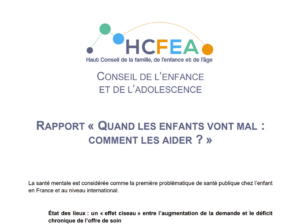
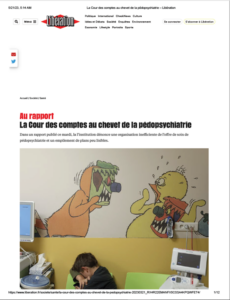


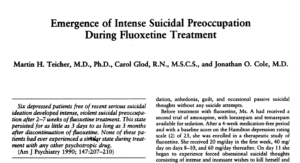
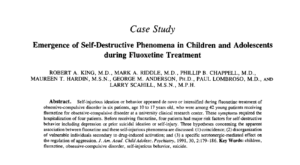
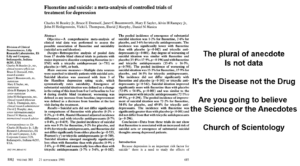




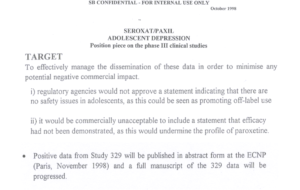
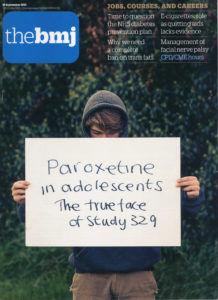

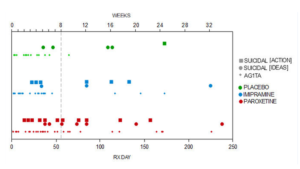



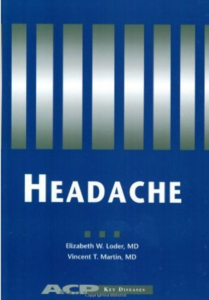
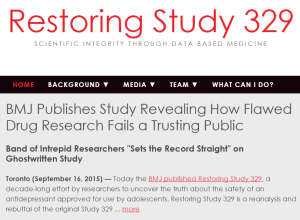
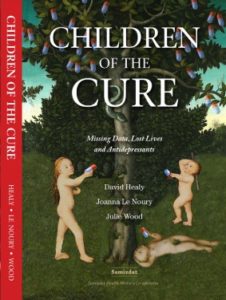

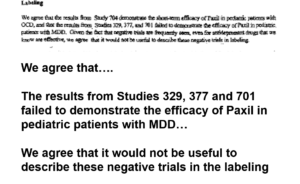
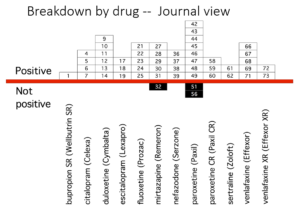
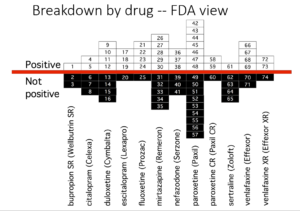
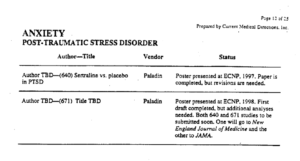
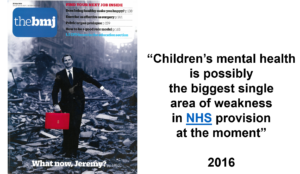
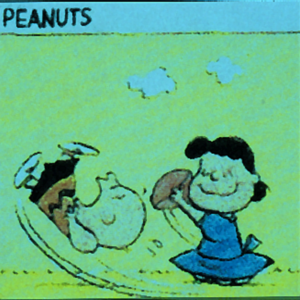
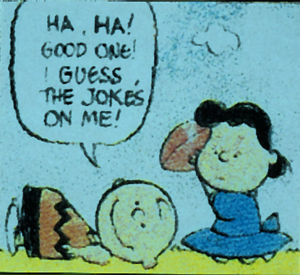

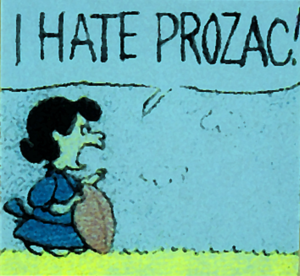
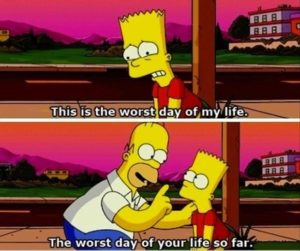
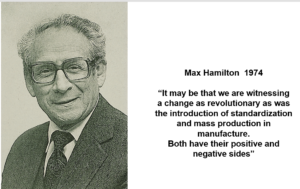
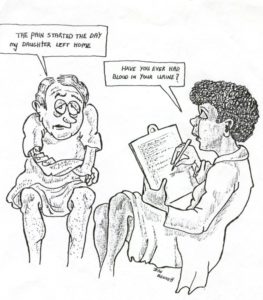
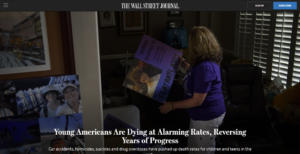
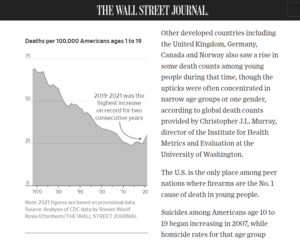

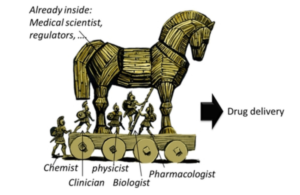
How on Earth did GlaxoSmithKline get away with it?
Drawing on one SSRI, Paroxetine, the One in Which, GlaxoSmithKline paid a fine of $3 Billion; the One in Which, GlaxoSmithKline, Lost the Court Case, in 2001
https://www.bmj.com/content/322/7300/1446.3
Look at this array of comments
https://www.bmj.com/content/322/7300/1446.3/rapid-responses
“they should be jumping out nursing home windows in droves.”
GlaxoSmithKline “Lost” the Court Case
Shouldn’t that have been the End of Paroxetine?
So warm –
Dan Johnson lost his 15 year old son to Fluoxetine.
Dan is a Professor – biogeography, agriculture, biodiversity, data, experimental design
https://davidhealy.org/in-memory-of-dexter-johnson/
Vincent Schmitt, a doctor in mathematics
“We find sources, we get in touch with the reference researcher in this field, the Irish psychiatrist David Healy. He is the only doctor who gave us a coherent explanation ”
Newsprint has followed GlaxoSmithKline and Paroxetine around in ever increasing circles; Panorama did five programmes on SSRIs; Study 329 debunked Paroxetine
Dexter and Romain are dead.
Protection of pharmaceutical companies, and their soulless drugs; Dan and Vincent deserve many answers…
Yoko and Vincent have made this beautiful website about their son Romain.
https://acopav.com/romain-16-ans/
Thanks Dan.
The English button didn’t translate, so here is the English version
https://acopav.com/romain-16-years-old/
ACOPAV
Association pour le COntrôle des Psychotropes et l’Aide aux Victimes
Reception
Barbarism on antidepressants
Open letters
Testimonials
The myth of serotonin
Blog
Useful links
By the way
Blog
https://acopav.com/blog/
Terrific resource of information…
Following…
Healy Lectures (Attention:
20/6 (evening): Barcelona (organized by the group of independent doctors La Capçalera)
Joan-Ramon Laporte Retweeted
THE SPIDERMAN
We announce the last date of the Teranyina this year Tuesday 6/20, a reflection on evidence-based medicine. By David Healy, Ariane Denoyel and Joan Ramon Laporte
@AteneuHarmonia @_FoCAP_
https://twitter.com/capcalerabcn/status/1668914206521925633
Juan Gérvas Retweeted
Abel Novoa
@AbelNovoa
·
Imprescindible jornada en Barcelona con @DrDavidHealy Ariane Denoyel y @joanrlaporte
para debatir sobre el texto del Dr. Healy “Dios no juega a los dados ¿deberían hacerlo los médicos?” traducido aquí
https://nogracias.org/2023/05/22/dios-no-juega-a-los-dados-deberian-hacerlo-los-medicos-por-david-healy/…
Vía @capcalerabcn @_FoCAP_ y @nogracias_eu
https://twitter.com/AbelNovoa/status/1669243956335353858
Thank you very much for pointing out the error. It works now.
Nothing like perseverance…
I have seen nothing from Shelley Jofre –
It’s been a long time since Panorama did Programme 5 –
This is Programme 6 – gaining a lot of twitter momentum…
The Antidepressant Story
19 June 2023
https://www.bbc.co.uk/programmes/m001n39z
Teenage antidepressants ‘doing more harm than good’
5 February 2018
By Shelley Jofre
BBC Scotland health correspondent
https://www.bbc.co.uk/news/uk-scotland-42917452
Over the years Shelley has continued her investigations into Seroxat, resulting in four films, which have forced a complete rethink of the drug’s safety and effectiveness as well as an overhaul of the way patients report side effects from any prescription medicine.
https://www.bbc.co.uk/programmes/profiles/47qj6F2mySgbBD5gV6QbGFw/shelley-jofre
Scottish journalist Shelley Jofre, having learned about the Schell case, did some research on the drug and arranged to do a program on paroxetine, known as Seroxat in the U.K., for BBC’s Panorama. The segment, Secrets of Seroxat, aired in October 2002. It revealed that the drug can cause suicidal and violent thoughts and behaviours, and that many people experience serious withdrawal problems. The show received such a huge public response that a second episode was developed, Emails from the Edge.
Following Secrets of Seroxat, the U.K. public was highly sensitized to the potential problems associated with paroxetine. In December of the year that Emails from the Edge was broadcast, the Medicines and Healthcare Products Regulatory Agency (MHRA) issued an advisory warning to physicians against prescribing SSRI antidepressants, including Seroxat, to people under age 18.
In June of 2004, New York State Attorney General Elliot Spitzer filed a lawsuit accusing British drug giant GlaxoSmithKline PLC of “repeated and persistent fraud” for concealing known problems with efficacy and safety of Paxil (paroxetine) for children and adolescents. Evidence was largely based on documents that had come to light in the Tobin case. The suit was settled for $2.5 million plus a promise by GSK that they would make their drug trial data accessible. Later that year, the FDA required that a “black box” warning label be added for all SSRI antidepressants, including Paxil.
In 2008, US Senator Chuck Grassley investigated serious violations of conflict of interest policies among high-profile academic psychiatrists, including Martin Keller, lead author of Study 329, and three of his coauthors. Senator Grassley’s investigation brought attention to the fact the nominal authors in many research studies are not the real authors. This was the case in Study 329. GSK hired a “ghostwriter”, Sally Laden of STI, to write the study article under GSK direction.
https://davidhealy.org/the-troubled-life-of-study-329-the-consequences-of-failure-to-retract/
It takes a while to make a Programme; Dexter and Romain won’t be in this Programme.
recovery&renewal Retweeted
Tony Kendrick
@tony_kendrick
I was interviewed for this programme due to be aired a week tomorrow. I hope they show me as having a balanced view of the pros and cons of antidepressants, and report the main findings of our REDUCE deprescribing programme.
@UoS_PrimaryCare @UoS_Medicine @CCCAHP_UoS @PHG_Soton
Wishy-Washy
https://www.madinamerica.com/2016/08/interview-researcher-runs-trial-antidepressant-withdrawal/#:~:text=Tony%20Kendrick%2C%20a%20professor%20of%20Primary%20Care%20at,and%20support%20necessary%20to%20get%20off%20of%20them.
David Taylor
@DavidTa23968240
·
40m
They interviewed me too, Tony. Also, hoping my views are accurately reflected. I was interviewed for two hours. The inevitable condensing into a couple of minutes’ footage is always a concern.
https://bpspubs.onlinelibrary.wiley.com/doi/full/10.1111/bcp.14475
7 THE NEED FOR MORE RESEARCH
The ongoing REDUCE RCT will provide evidence on whether scalable, Internet and telephone psychological support to patients, and guidance on antidepressant tapering to practitioners, leads to more patients successfully coming off their antidepressants without becoming depressed.
This is one of the most ridiculous statements, I have ever heard…
Sounds like a Van Tulleken type prog. so far
If this is the height of expertise, I fear Shelley’s legacy will be sorely wasted…Shelley told the Story of Antidepressants, and this cannot be fulfilled in one programme with Doctors constantly measuring their words, and not addressing Panorama Five…
https://twitter.com/tony_kendrick
Politically, Kendrick is a ‘nasty piece of work’
Let’s, Live in hope that The Antidepressant Story covers, in the main, Pharma Political Manoeuvrings…
Leaky Umbrellas…
Just checking in
Thanks Kendrick, for the Alert
Tony Kendrick Retweeted
Robert Howard
@ProfRobHoward
https://twitter.com/tony_kendrick
Published16 June 2023
“The proven efficacy of SSRIs in a proportion of people with depression lends credibility to this position.”
A leaky umbrella has little value: evidence clearly indicates the serotonin system is implicated in depression
Sameer Jauhar, Danilo Arnone, David S. Baldwin, Michael Bloomfield, Michael Browning, Anthony J. Cleare,Phillip Corlett,J. F. William Deakin, David Erritzoe,Cynthia Fu,
Paolo Fusar-Poli, Guy M. Goodwin,Joseph Hayes, Robert Howard,Oliver D. Howes,Mario F. Juruena,Raymond W. Lam, Stephen M. Lawrie,Hamish McAllister-Williams,Steven Marwaha,David Matuskey, Robert A. McCutcheon,David J. Nutt, Carmine Pariante, Toby Pillinger,Rajiv Radhakrishnan,James Rucker,Sudhakar Selvaraj,Paul Stokes,Rachel Upthegrove, Nefize Yalin, Lakshmi Yatham,Allan H. Young, Roland Zahn & Philip J. Cowen
https://www.nature.com/articles/s41380-023-02095-y
A recent “umbrella” review examined various biomarkers relating to the serotonin system, and concluded there was no consistent evidence implicating serotonin in the pathophysiology of depression. We present reasons for why this conclusion is overstated, including methodological weaknesses in the review process, selective reporting of data, over-simplification, and errors in the interpretation of neuropsychopharmacological findings.
Tony Kendrick Retweeted
Robert Howard
@ProfRobHoward
·
5h
Our response to *that* serotonin umbrella review and the methodological flaws, notable literature omissions, scientific misunderstandings and biases that undermine its reliability. Failure of peer review and Journal accountability (look at submission date)
https://www.nature.com/articles/s41380-023-02095-y
Kindly #deprescribe — taper psychiatric drugs
@Altostrata
·
2h
“Serotonin is implicated in depression”just as the hundreds of other neurohormones & hormones that run the human body are implicated.
#WeaselWords tend to erode credibility themselves. Your point, Dr. Howard is to smear the researchers, not to disagree with their conclusions.
Responses/J. Moncrieff
https://twitter.com/JoannaMoncrieff
Michael P. Hengartner, PhD Retweeted
Dr Joanna Moncrieff
@joannamoncrieff
·
2h
Our response to letters on our serotonin review ‘It seems the situation is the same as when David Healy described the monoamine hypothesis of depression as a failed Kuhnian paradigm. No one believes it, but no one wants to let it go either.’
https://rdcu.be/deDRE
@DrDavidHealy
Mark Horowitz Retweeted
Michael P. Hengartner, PhD
@HengartnerMP
·
2h
There was a lot of misunderstanding and misrepresentation of our serotonin review as demonstrated in various letter to the editor. Our comprehensive response and rebuttal here:
https://www.nature.com/articles/s41380-023-02094-z.epdf?
@joannamoncrieff @markhoro
CORRESPONDENCE The serotonin hypothesis of depression: both long discarded and still supported?
Demands for ‘flawed’ study that cast doubts on the effectiveness of antidepressants to be AXED
University College London claimed low serotonin levels not linked to depression
But another group of doctors has criticised the research published last year
By ETHAN ENNALS
UPDATED: 23:12, 17 June 2023
https://www.dailymail.co.uk/health/article-12206165/Demands-flawed-study-cast-doubts-effectiveness-antidepressants-AXED.html
A group of doctors are calling for an influential study that cast doubts on the effectiveness of antidepressants to be retracted, claiming it contains ‘repeated mistakes’ and errors that amount to misinformation.
Last year, researchers at University College London said they had disproved a theory dating back to the 1960s that depression is caused by low levels of serotonin – a chemical in the brain believed to control mood.
Led by Prof Joanna Moncrieff, a respected consultant psychiatrist, the study had analysed decades worth of research involving tens of thousands of patients with depression and controversially concluded that there was ‘no convincing evidence’ of a link between the illness and serotonin.
Most antidepressants, taken by more than seven million Britons, are designed to boost serotonin levels. But now nearly 40 experts have put their name to a paper which accuses Prof Moncrieff and her colleagues of ‘substantial bias’ against antidepressants.
One of them, Prof David Nutt, head of the centre for neuropsychopharmacology at Imperial College London, told The Mail on Sunday: ‘This paper is full of flaws and it should never have been published in the first place. Yet it has been frequently cited and people believe it is true. It’s essentially misinformation.’
The new paper, published in the scientific journal Molecular Psychiatry, argues that Prof Moncrieff and her colleagues selectively chose to analyse only historical studies which backed the theory that there was no link between serotonin and depression.
‘The authors of this study made repeated mistakes in their research which suggests they don’t understand how depression affects the brain,’ says Dr Sameer Jauhar, a clinical lecturer in affective disorders and psychosis at King’s College London.
‘These are drugs which can save lives. The evidence backs that up, too.’
Prof Moncrieff said: ‘The bottom line is that the authors didn’t want us to do the review because they didn’t want to let the cat out of the bag that there is no evidence of a biological basis to depression.
‘We used approved and well-accepted methods and it is incorrect to say we missed out studies. No one believes the serotonin theory of depression any more, but no one wants to let it go because it provides a convenient myth to support the prescribing of antidepressants.’
Howards End…
Robert Howard Retweeted
M
@micmicmic1
·
Demands for ‘flawed’ study that cast doubts on the effectiveness of antidepressants to be AXED | Daily Mail Online
https://www.dailymail.co.uk/health/article-12206165/Demands-flawed-study-cast-doubts-effectiveness-antidepressants-AXED.html
Robert Howard Retweeted
Tyler Black, MD
@tylerblack32
Oh look, Elon once again elevating the “meds don’t work” position. Let’s Be very very very clear: all ssri studies show a **positive** effect size. There is debate as to the size of the effect, but it’s all in the “its benefits outweigh the risks on the whole” direction.
Elon Musk
@elonmusk
·
11h
Replying to @TheRabbitHole84 and @joerogan
There is an argument that the negatives of SSRIs outweigh the positives
“Murky Stuff”
https://holeousia.com/2023/06/19/murky-stuff/
recovery&renewal Retweeted
Dan Johnson
@DanJohnsonAB
·
6h
Replying to @JDaviesPhD
It would make science discussions clearer if authors and speakers had to wear jackets covered with the logos of their recent financial sponsors, like race car drivers do.
‘I struggled to come off antidepressants – so I looked into the science’
Story by Roisin Dervish-O’Kane • 6h ago
60mg of fluoxetine –
https://www.msn.com/en-gb/health/mindandbody/i-struggled-to-come-off-antidepressants-so-i-looked-into-the-science/ar-AA1cJQvs?ocid=msedgdhp&pc=U531&cvid=179adb8b469e4af59507f5b74899b8a5&ei=13
To better understand the mechanics of what went on in my brain when I lowered my dose of fluoxetine, I put in a call to one of the academics who authored the Lancet Psychiatry review; Professor David Taylor, director of pharmacy and pathology at the Maudsley Hospital in London.
His answer was unexpected. ‘I don’t think anyone really knows,’ he says. While some blame this knowledge gap on the failure of the pharmaceutical industry to properly research SSRI withdrawal, that’s just part of the story. Not even the most learned academics and doctors really understand the mechanics of how SSRIs work.
‘They block the reuptake of serotonin into the brain’s neurons,’ says Professor Taylor, explaining that reuptake essentially restricts the amount of serotonin available to the brain, and SSRIs work to reverse this serotonin-sapping process.
‘This may increase the mood and behaviour effects of serotonin as a neurotransmitter but, other than that, the process isn’t entirely clear.’
It follows, then, that doctors are similarly unsure when it comes to the impact of taking fewer pills.
For me, the scariest part of trying to reduce my medication was feeling just as unstable, incompetent and out of control as I had before my first prescription, even though I was still taking 83% of my usual dosage.
Ye, gads
The investigation also uncovered evidence that a leading drug company attempted 27 years ago to conceal possible withdrawal effects that one drug could cause.
The Story of Antidepressants
https://www.bbc.co.uk/news/uk-65825012
The Royal College of GPs told Panorama that family doctors were “highly-trained to have frank and sensitive conversations” with patients about the risks and benefits of antidepressants.
Oh, really, O’Reilly?
For serious ‘Panoramics’
https://www.bbc.co.uk/programmes/m001n39z
Shelley Jofre
@ShelleyJofre
Incredible it took so long. We first highlighted SSRI withdrawal problems on Panorama in 2002 with @DrDavidHealy & evidence from Pharma healthy volunteer studies & a powerful video diary of a young woman experiencing head shocks and dizziness as she tried to stop her medication.
9:26 PM · Jun 19, 2023
Loss of “Sex” came to the fore, in The Story of Antidepressants, a first for putting PSSD on the TV map and a very powerful message it was too.
“I’ve been waiting for you to show up for 15 years.”
My heart gave a lurch when Wendy Burn attributed antidepressants to “Disneyland”. She kept appearing, in little segments, but, little by little, she did make an attempt at an apology to those harmed —-
RCPsych responds to BBC Panorama programme on antidepressants
https://www.rcpsych.ac.uk/news-and-features/latest-news/detail/2023/06/19/rcpsych-responds-to-bbc-panorama-programme-on-antidepressants
The format of the programme, the little segments, almost teasers, gave the little glimpses as the stories were returned to, each one almost a vignette, split in to parts. So we caught up with Mark Horowitz, by far a star, who has a hellish time getting off antidepressants.
Tony Kendrick
@tony_kendrick
A shame the programme didn’t mention our REDUCE programme of internet and telephone support for people coming off long term antidepressants which reduced depressive and withdrawal symptoms. We are reporting the results to the finder & presenting them soon.
Not quite the bite of Shelly, and her teasing out of the Pharmaceutical corruption and suicides, homicides and violence, but, maybe we can come back to that…
David Healy’s point about “Sex” and the media, is clearly here…
https://www.dailymail.co.uk/health/article-12212335/Two-million-Brits-hooked-antidepressants-taking-half-decade.html
Quite a polished Panorama production…